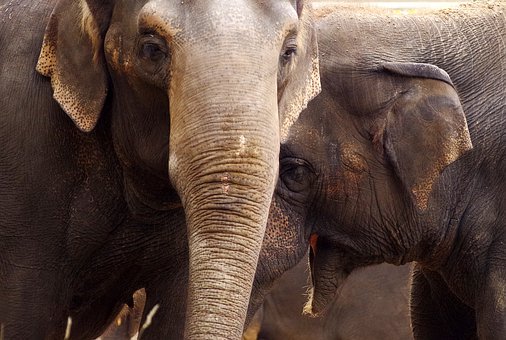An elephant’s skin can be more than an inch thick.
But their thick skin doesn’t make them impervious to heartbreak and loneliness. And they’re able to communicate their pain – as well as joy and contentment – if you’re willing to listen. There are some heart-warming examples of humans paying attention to elephant language, like when these elephants reunited back in 2008.
Here’s the story about Jenny and Shirley, and the lessons they taught us about an elephant’s unique personalities…and why it’s so important to learn how to communicate with animals.
Elephants, the gentle giants
Elephants – the largest mammal walking the earth – are extremely social and sentimental creatures. In the wild, they’re organized in birth families, bond groups, clans, led by a matriarch. They function as interdependent groups, coming together to socialize and share information, then separating again.
If calves are forcefully separated from a wild herd they will form a strong bond with their human caregiver. They’ll look to their captor as a surrogate parent because it’s in their nature to form a trusting, mentoring bond.
Elephants reunited after years of separation from their herd will sometimes struggle to reestablish themselves as part of a family, group, or clan. The process can be distressing…
An elephant who wished she could forget
Advocates in the United States – and around the world – are pushing for vast improvements to the rules around destructive human practices like trophy hunting and keeping elephants in captivity. There’s still much work to do, but great strides are being made…and Shirley is an excellent example.
For just one winter she had shared a bond with Jenny – who was then a calf in the same circus as Shirley – before they were separated. Shirley was later moved to the Dallas Zoo, where she briefly had a partner…but was left completely alone when her companion was sent away for breeding.
Shirley lived a life of solitude for 22 long years.
After tireless efforts by animal rights advocates, Shirley was brought to a sanctuary and reunited with a new herd that included Jenny. It was clear that when these elephants reunited there was instant recognition and deep affection.
Elephant communication has many layers
If you watched the video, you saw very specific physical contact between Jenny and Shirley – one of the many ways elephants communicate with their own kind.
Elephants communicate with each other through:
-
Airborne sounds
Elephants can produce a variety of sounds, which emanate from their trunk, mouth, forehead, and chest.
These sounds include roars, barks, clicks, purrs, rumbles, and snorts, which carry through the air. They can detect the airborne calls and recognize who is making them from a distance of 1 mile. Elephants can distinguish among the calls of family members as well as the contact calls of non-related groups.
-
Seismic
Elephants also produce low-frequency rumbles known as seismic or infrasound, which are inaudible to the human ear. The rumble sends infrasound signals through the elephant’s feet into the ground and can carry underground for as far as 30 miles.
Although humans can’t hear the sounds, we can feel and see the elephant’s forehead and chest vibrating.
-
Body language
Elephants use their body, head, eyes, mouth, ears, tusks, trunk, tail, and feet to communicate with each other and other species.
-
Touch
Elephants are highly tactile, using touch when they play, express affection, reassure, act aggressively or defensively, mate, care for others, and explore.
-
Chemical
Smell is one of the elephants’ strongest senses. They pick up smells from the air and the ground, from urine and dung and from other elephants’ genitals, temporal glands, and mouths.
Elephants can identify groups of people who pose a threat to them from their scents and use smell to keep track of family and friends. They can smell an approaching rainstorm from 150 miles away.
Source: Elephant International
So that’s how elephants communicate with other elephants. How do they communicate with us?

Learn how to communicate with elephants…and other creatures
There are some physical and verbal cues humans can understand when trying to communicate with elephants. When those two elephants reunited you didn’t have to be an expert to see the joy and contentment Jenny and Shirley were experiencing.
But if you really want to help animals get through to humans when their needs aren’t being met, it’s helpful to have the training necessary to truly “hear” what the dog, cat, bird, iguana, or elephant is trying to say.
That’s when the help of a professional pet communicator, or training as a pet communicator, will be so helpful. When you have the skills and training, you can make a real difference in the lives of animals…you can speak for them in a voice that not everyone understands.
You can become a translator for animals in distress, and animals who see their humans in distress and want to help. It can be extremely rewarding, and in some cases can even save a life.
If you’d like to learn more about elephant – or animal – communication, there are so many resources you can access. Start your journey as a professional animal communicator and start making a difference in the lives of those who can’t always help themselves.
If you want more posts about animal communication, check out these:
A Connection with Animals is About More Than Play and Rest
Things I’ve Learned As An Animal Whisperer By Val Heart
The Extraordinary Soul Connection I call The Human Animal BodyMind Connection
The post Watch the Magic That Happened When These Elephants Reunited appeared first on Val Heart.
source https://valheart.com/elephant-communication-and-reunited-after-20-years/
No comments:
Post a Comment